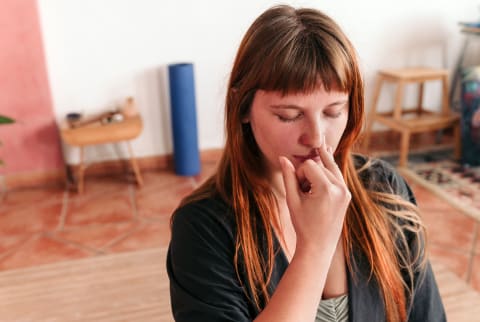Advertisement
5 Quick But Powerful Ayurvedic Practices You Can Do In Under 15 Minutes A Day


The ideal Dinacharya (daily practices) for staying healthy occupy a generous amount of space in ancient Ayurvedic texts. A large part of the Ayurvedic literature details how to live in a manner that leaves no room for disease. The caveat is that if you worked every single practice into your life, you'd have very little time left to do anything else!
Growing up in a large Ayurvedic family and working with over 1,000 people as an Ayurvedic practitioner, I have spent my life thinking about how to carry these Dinacharya into the modern day.
Here are my top five Ayurvedic practices that support all facets of health—and can be completed in under 15 minutes a day.
Nasya (for your brain and beyond)
Time: 1 minute or less
How to: Lie down, tilt your head backward, and prop it on a pillow. Instill two drops of Anu tailam (an Ayurvedic oil for sinus relief) in each nostril. It may feel a little sharp if you are new to Nasya, but it should settle within the week.
Benefits: "Nasa hi siraso dwaram"—Sanskrit, Carak Samhita... The nose is the only gateway to the brain.
The ancient texts of Ayurveda pointed out that the nose is the only organ that surpasses the blood-brain barrier, something that scientists in the West are discovering today.
This practice goes beyond lubricating your nostrils, preventing allergies, opening up your sinuses, and decongesting phlegm. In fact, the main benefits of this practice are deeper than your ENT region.
When administered through the nose, Nasya drops are thought to nourish cerebrospinal fluid1, the juiciest of the brain and spinal fluids, which has also been linked to Alzheimer's and certain types of dementia. Nasya is also known to give restful sleep, better vision, delayed graying, and lubrication of the jaw. So this one is a no-brainer!
Tongue scraping (to stimulate digestion)
Time: A few seconds
How to: Use a copper tongue scraper with a curved edge, and hold the two sides. Extend your tongue and gently scrape your tongue with the arched side of the scraper. Ideally, this is done after brushing your teeth. Avoid if you have mouth sores.
Benefits: It is often forgotten that the tongue is one end of the digestive tract and that metabolic processes in the gut can affect the tongue2. Scraping the tongue (Jivha Nirlekhana) to clean out this coating gently refreshes the digestive system, stimulates the taste buds and the digestive fire, and promotes oral hygiene. In my opinion, it is as essential as having a bowel movement; after all, both processes eliminate waste.
Abhyanga massage (to delay aging)
Time: 6-7 minutes
How to: Take warm sesame oil or an Ayurvedic oil and massage your body, starting from the top of your head and moving down to your face, chest, abdomen, and limbs. The massage can be in a circular motion, especially over the joints or long movements for the limbs. Follow with exercise and a bath. Avoid Abhyanga if you are sick or have an inflamed skin condition.
Benefits: The word for "oil" in Sanskrit is the same as the word for "love": Sneha. This loving practice of oil massage is not just skin deep. According to Ayurvedic science, besides moisturizing the skin, Abhyanga can regulate the nervous system and Vata3, delay aging, nourish deeper tissues such as the bone marrow, tone muscles, increase strength, promote restful sleep, and bring peace.
Alternate nostril breathing (to bring equilibrium)
Time: 4-6 minutes
How to: Alternate nostril breathing is best done on an empty stomach after yoga-asana practice. But it can be repeated a few times daily, especially when you feel less grounded. Start with four cycles, and move up to eight, 16, and so on. I like doing four complete morning rounds and eight before bedtime for deeper rest.
Benefits: This particular breathwork (pranayama) practice comes from the Yogic tradition but certainly deserves a place in anyone's daily routine. It is a specific breathing technique that involves inhaling and exhaling from the left and right nostrils while blocking the other. According to Yogic scriptures, the two nostrils carry unique subtle energies; the left carries masculine energies (water), and the right nostril carries feminine energies (heat).
When these two energies are imbalanced, homeostasis is disturbed, and physical and mental dis-ease can occur. Alternate nostril breathing balances both energies, both sides of the brain, and instantly reduces anxiety4, bringing peace and calm.
Walking after eating (to enhance digestion after every meal)
Time: 2-3 minutes
How to: Walk 100 steps at a gentle pace right after meals. If you can, follow up with Vama Kuksi (explained below).
Benefits: Ayurvedic science leaves nothing to guesswork. It tells you what to eat, how, and when. Even when you have done it all correctly, it supports you through post-meal digestion.
Walking 100 to 200 steps after eating (Shad Pavli) is recommended to get the food to move and settle in the gut, stoke the agni or digestive fire, and gently enhance digestion.
What follows this recommendation is even more fun: Vama Kuksi is the practice of lying down on your left side with your head propped against your elbow for 20 minutes to get the food moving downward into the colon. With desk jobs today, while Vama Kuksi is not always possible, you can steal a few minutes for Shad Pavli almost anywhere.
The takeaway
Adopt these five practices regularly and notice the difference they make in your breathing patterns, sleep, skin, mood, digestion, and overall physical and mental well-being. Not bad for 14 to 15 minutes out of the 1,440 minutes in a day.